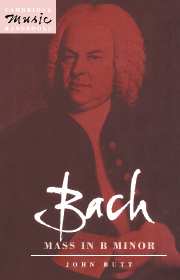Book contents
- Frontmatter
- Contents
- Preface
- List of abbreviations
- 1 The musical genre of the mass Ordinary
- 2 Genesis and purpose
- 3 Reception history
- 4 Text and music: the process of adaptation and composition
- 5 Ritornello forms
- 6 The influence of the dance
- 7 Counterpoint
- 8 Figurae and the motivic texture
- 9 Patterns and proportions: large-scale structuring and continuity in the Mass in B Minor
- Afterword
- Notes
- Select bibliography
- Index
6 - The influence of the dance
Published online by Cambridge University Press: 05 June 2012
- Frontmatter
- Contents
- Preface
- List of abbreviations
- 1 The musical genre of the mass Ordinary
- 2 Genesis and purpose
- 3 Reception history
- 4 Text and music: the process of adaptation and composition
- 5 Ritornello forms
- 6 The influence of the dance
- 7 Counterpoint
- 8 Figurae and the motivic texture
- 9 Patterns and proportions: large-scale structuring and continuity in the Mass in B Minor
- Afterword
- Notes
- Select bibliography
- Index
Summary
Two factors are particularly important in distinguishing the society of Bach's age from that of the modern western world. First there was the universal acceptance and practice of various forms of the Christian religion which influenced all structures of thought and politics. Secondly there was the hereditary domination of the upper classes. Both these forces were, of course, under attack during Bach's lifetime, but their potency is impossible to ignore. So far, this study has taken the religious background of what is patently a religious work into account, since Bach was, for much of his working life, associated with ecclesiastical institutions. However, his career in court life should not be forgotten, nor should the modish influences of his age – opera, and courtly dance music which aped the fashions of Versailles – be ignored. Indeed such was the nature of Lutheran music at this time, with the librettos heavily influenced by the structures of operatic text, that secular elements inevitably infiltrated the church style.
Dance music not only became a profitable product for the late Baroque composer, it also provided a stable framework on which to elaborate various ideas and processes. The importance of binary forms in the Classical era reflects just how much dance forms had become absorbed by the prevailing idioms. Periodic structure and possibly tonality itself could hardly have been developed without a long tradition of dance composition.
- Type
- Chapter
- Information
- Bach: Mass in B Minor , pp. 70 - 76Publisher: Cambridge University PressPrint publication year: 1991

